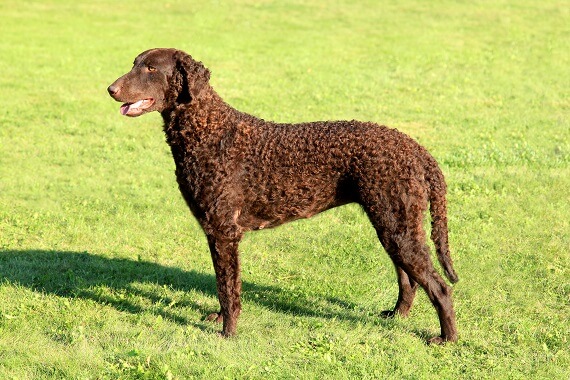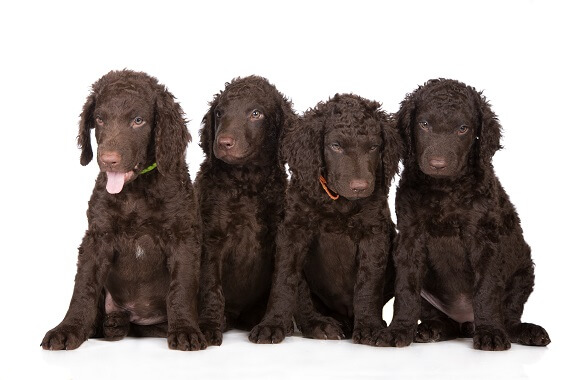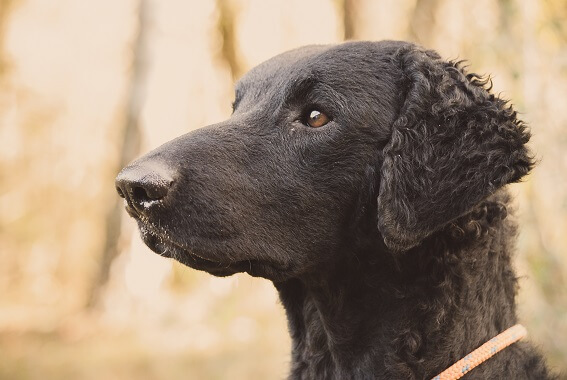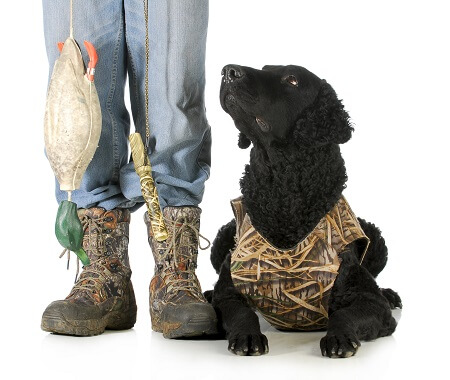
The curly coated retriever is one of the oldest retriever breeds. It was first shown in England in 1860. It is a fearless gun dog that was bred to retrieve game – mostly ducks and quail – both on land and from the water. This breed was popular amongst English gamekeepers, hunters, and poachers for its retrieving abilities. Today is it still used as a working dog but is also found competing in dog sports, such as agility, as well as working as therapy dogs. These retrievers have also been used in search and rescue missions. As the name suggests, this dog has a curly coat that provides protection from its environment, allowing it to carry out its work effectively. These retrievers are either black or liver-colored, with a long head and ears that are set rather low. Curly coated retrievers are moderate shedders. The curly coated retriever is a big, durable gun dog that is muscular and agile and it comes across as more elegant than the other retriever breeds, which includes labradors and golden retrievers. It is the largest of the six retriever breeds. This dog is highly intelligent and easy to train, although some can be stubborn. They require consistent training to ensure that they don’t become bored and unruly. Potential owners should also be aware that this dog is slower to mature than other breeds, which means that the puppy stage can last longer. Like other retrievers, the curly coated retriever is loyal, affectionate, and playful. This breed is slightly more independent than some of the other retriever breeds and therefore not as needy. Unlike other retrievers who are quick to make friends, these dogs are warier of strangers which can make them more suited to guarding than other retrievers. They are high energy and require lots of outdoor exercises as a bored curly coated retriever can be a bit of a handful. The curly coated retriever is one of six retriever breeds that have been bred as hunting companions. While it is lesser known than some of its relatives, this retriever is a great hunting companion and has several biological adaptations that make it suited for life in the great outdoors. Let’s take a closer look! Curly coated retrievers are known for their curly coat which is unique among the retriever breeds. Ths dog has a single coat made up of small, dense curls that lie close to the skin and protect it from brambles and any other rough vegetation that it may encounter when retrieving game. These tight curls are also waterproof, providing protection from icy water and wet weather. The fur around the head and ears is often wavy or straight. These dogs will sometimes have longer fringes of hair around their belly, ears, thighs, and back of the forelegs which is often trimmed. Curly coated retrievers do not need regular grooming and bathing, making it lower maintenance than other retriever breeds. Curly coated retrievers are renowned for their soft mouth which is one of the characteristics that make them exceptional hunting companions. A soft mouth, or bite inhibition, refers to a behavior in carnivorans where the animal learns to control the strength of its bite. This is an important characteristic in dogs that are retrieving game as a hard bite can result in bite makes left in the birds. A soft mouth ensures that the bird is retrieved undamaged and not half-chewed which would make it inedible. Many retrievers naturally have a soft mouth but those that grip too hard can be trained to loosen their grip through dedicated training. While some people think that you can train a dog to reduce its bite and be soft-mouthed, some breeds are naturally more soft-mouthed and preferred by hunters. This includes all the retriever breeds as well as cocker spaniels and the Gordon setter. The curly coated retriever originated in the United Kingdom and written records of its existence date back to the early 1800s. However, this dog has only been purebred since the early 1900s, so exact records of its lineage do not exist. Although its exact ancestry is unknown, it is thought that it could have been bred from crosses of the old English water dog, Irish water spaniel, and a small Newfoundland. It is possible that it also has some poodle ancestry. The population of the curly coated retriever has fluctuated over the years and was greatly impacted by both world wars which resulted in a decrease in its numbers. While the curly coated retriever used to be popular among hunters and gamekeepers, today the labrador retriever and golden retriever are more popular which means the number of curly coated retrievers has become limited.
Kingdom
Animalia
Phylum
Chordata
Class
Mammalia
Order
Carnivora
Family
Canidae
Genus
Canis
Species
Canis lupus
Subspecies
Canis lupus familiaris
Height
23 – 27 inches (58.4 – 68.6 cm)
Weight
65 – 80 lbs (29 to 36 kg)
Lifespan
10 – 12 years
Social Structure
Domesticated, sporting dogs
Status
Least concern
Natural Habitat
Domesticated, hunting dog
Average Litter Size
Varies
Main food item
Dog food
Potential predators
Few predators
The Basics

Fun Facts about the Curly Coated Retriever!
Single, curly coat

Soft Mouth

Purebred since the 1900s
